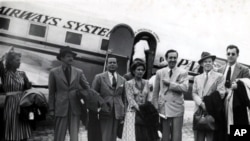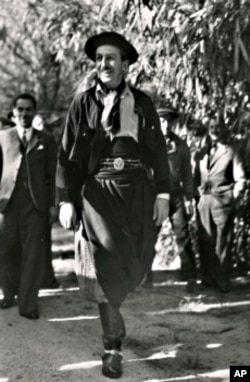In 1941, celebrated animator Walt Disney went on a diplomatic mission to Latin America. The creator of Mickey Mouse and Donald Duck became a good will ambassador. The U.S. had not yet joined its allies in war, but feared growing Nazi and Fascist influence in the Americas.
President Franklin Roosevelt had created a Good Neighbor Policy to improve relations in the hemisphere and Disney was asked to serve his country. Faced with a troubling animator's strike and the worldwide economic depression, Disney accepted the offer. "We were back to owing the bank $4.5 million. I just closed my feature production. That was all I could do."
Diplomats with sketchpads
In August of that year Disney and his team of artists, writers and composers set out on a 10-week journey to the region. Filmmaker Ted Thomas recreates the trip in the documentary, "Walt and El Grupo [the Group]."
Thomas says the 39-year old Disney was "energetic and charismatic. He met with artists and heads of state and he was seemingly up for whatever situation he was in. He was on-call from dawn until way past midnight every day."
Disney was already well known in Latin America and was treated as a hero. His team impressed their hosts wherever they went. And the American animators were inspired by new ideas, Latin American tunes and characters like the cigar-smoking Brazilian parrot Joe Carioca, who debuts in the 1942 animated live-action Disney travelogue called "Saludos Amigos," which was nominated for three Academy Awards that year.
According to Thomas, animator and illustrator Mary Blair was charmed by what she saw. "Before she went she was a very fine water colorist. This trip was a catalyst that changed her style completely. She had a different sense of color pallet, design and she became not only one of the top inspirational artists at Disney, but overall in the United States."
El Grupo
"Walt and El Grupo" explores a diplomatic mission of artists with sketchpads. Thomas says Disney and his team set in motion what Washington had hoped for: goodwill toward the United States. "Art has profound power in a beneficial way and can transform how we feel about each other. The most important step in getting to know each other is to start a dialogue and art and music can do that often that words cannot."
Those words mean something to senior animation student Sidney Marra, who attended a recent screening of the documentary at the Maryland Institute College of Art in Baltimore, Maryland. "It wasn't like his artwork was propaganda. It was more sending out a positive message, instead of trying to be against others. It was trying to unify others. That's what I want to do with my artwork. I want it to be a universal feeling among everybody."
Fellow animation student Tyler Naugle agrees. He says that take-away message for him from the film is an appreciation for place. "You really have to appreciate the environment that you're in, and be constantly observing it and appreciating it because that's where you get all your ideas."
Thomas hopes his documentary, which uses archival photos, letters, sketchbooks and home movies, will introduce film-goers to a unique cultural exchange that helped develop both political goodwill and creative talent.
"Walt and El Grupo" has played in theaters, museums, and film festivals across the United States. Its November 29 commercial release on DVD includes a bonus - the original 1942 animated live-action cartoon "Saludos Amigos."














